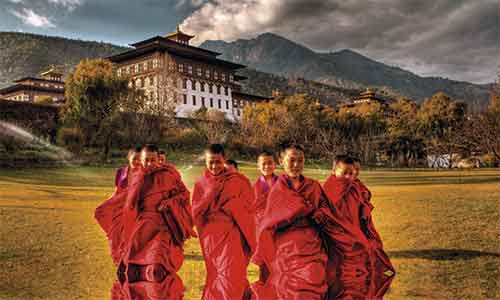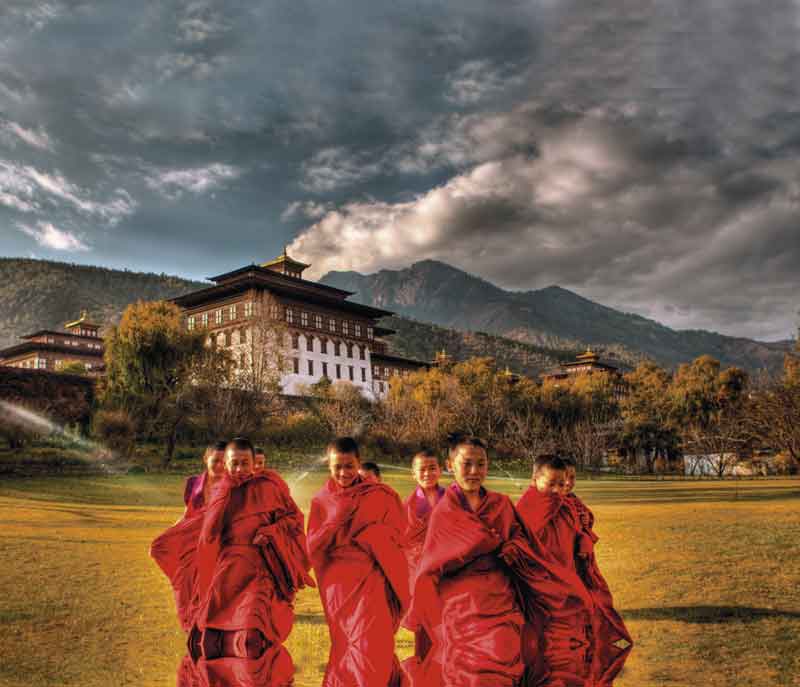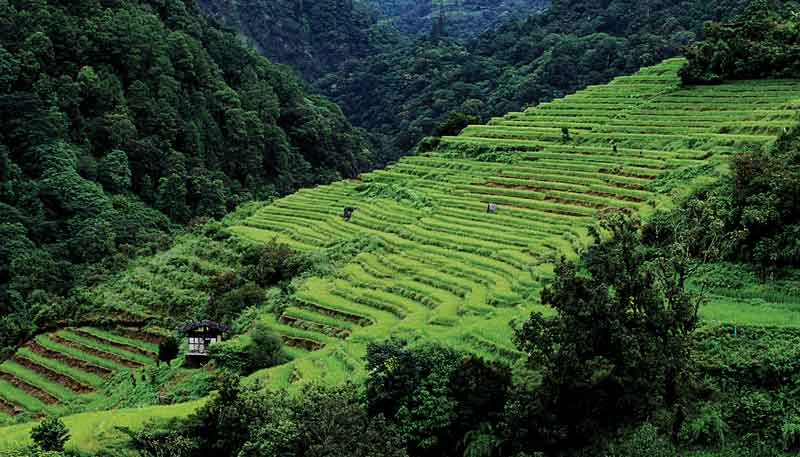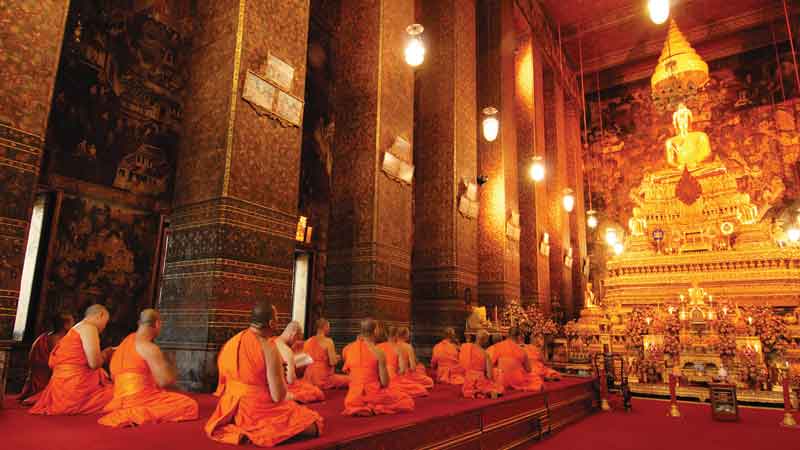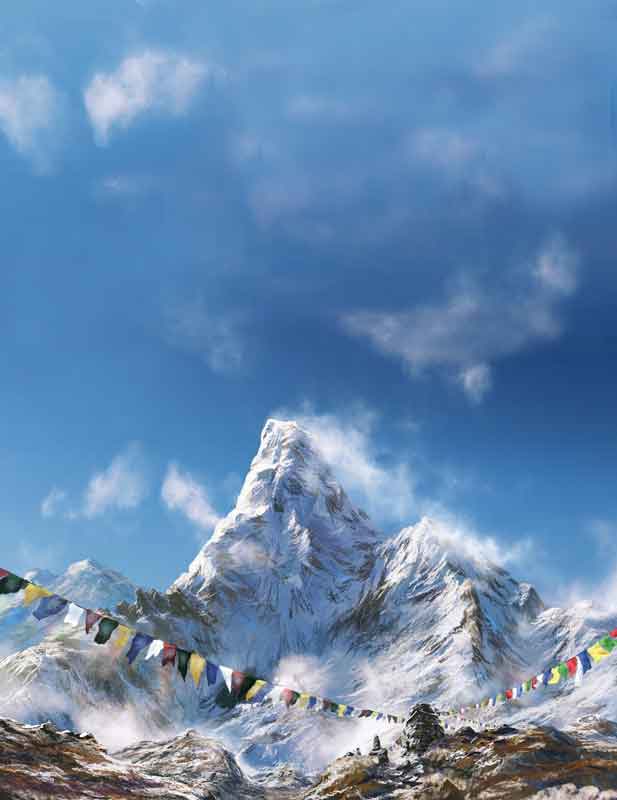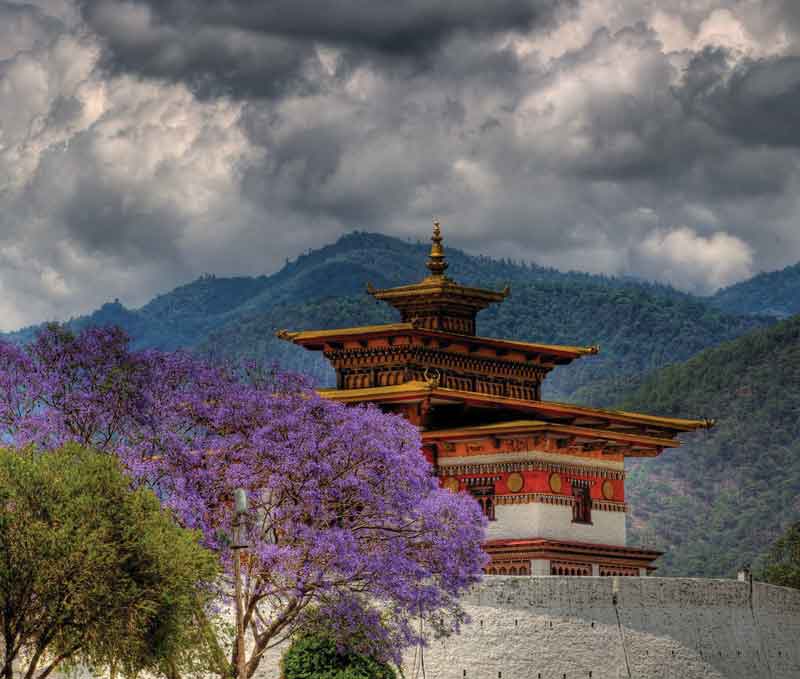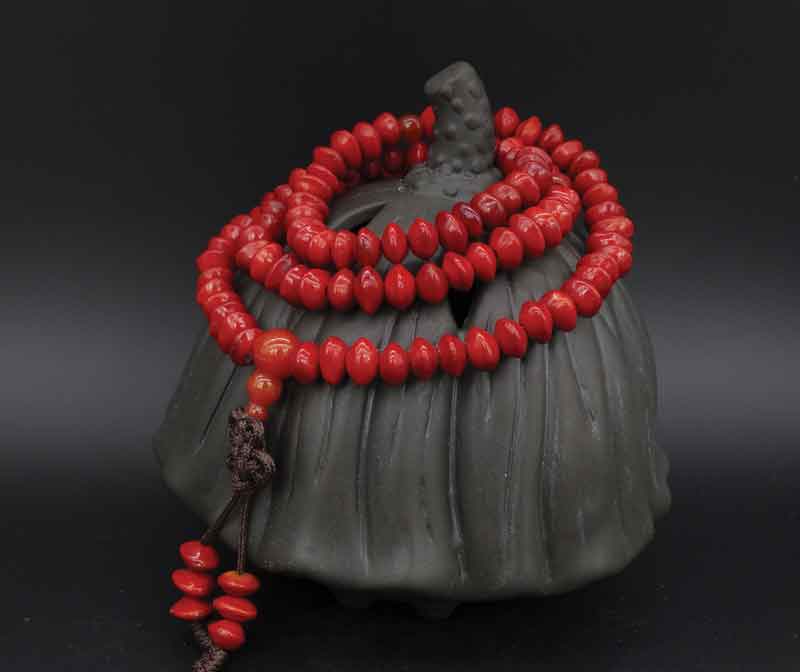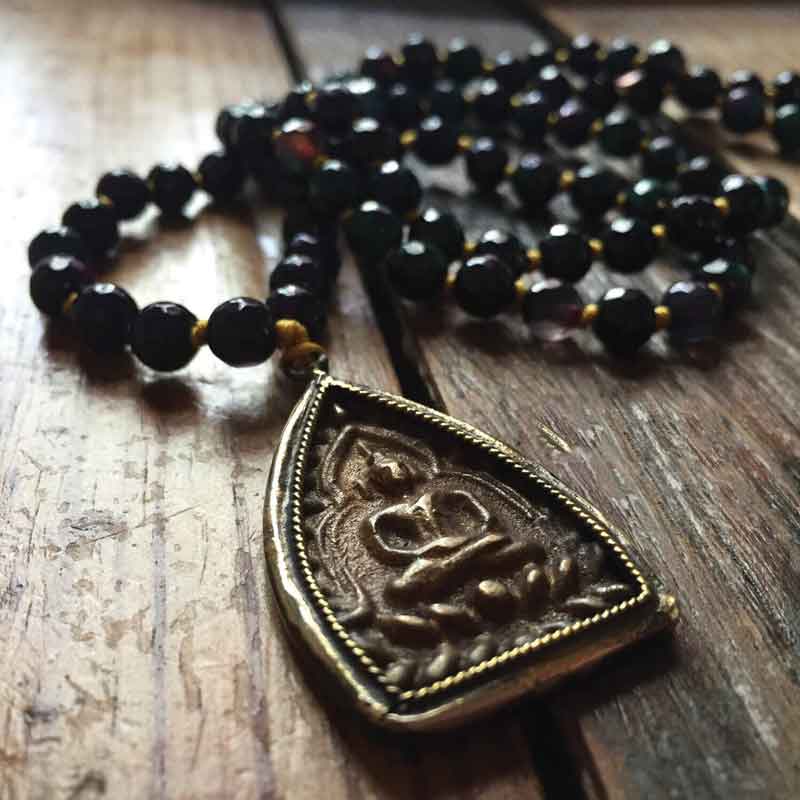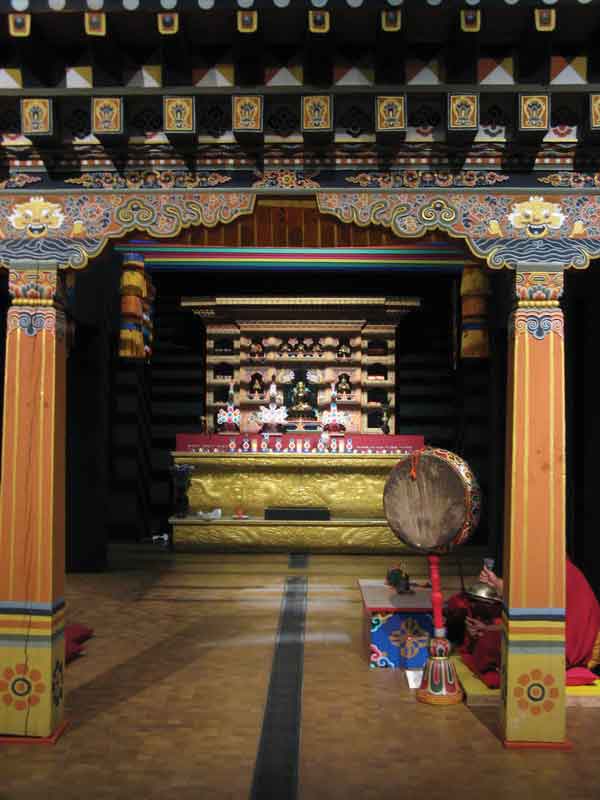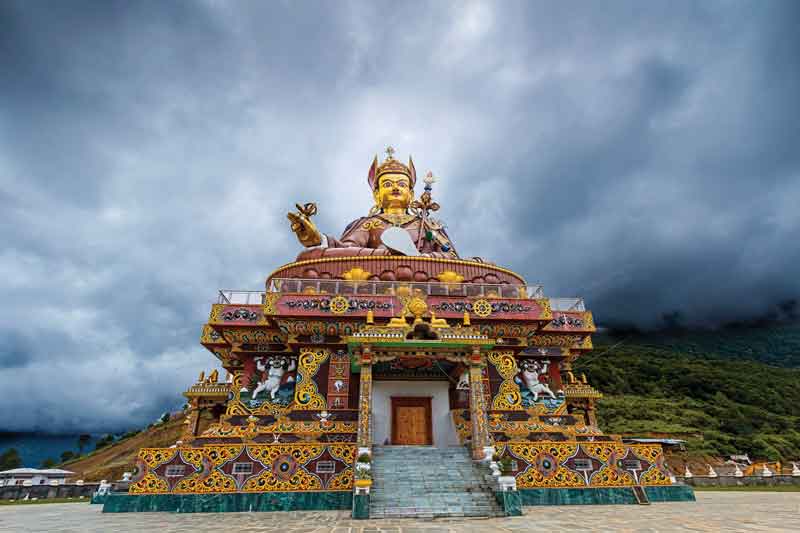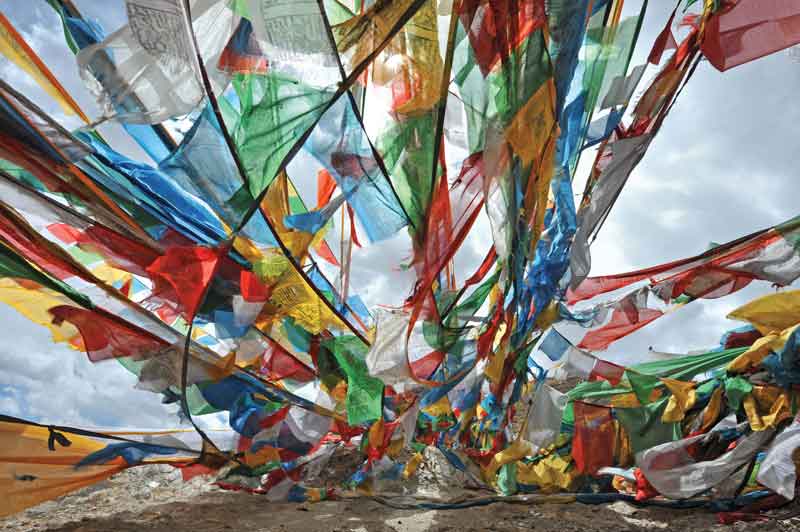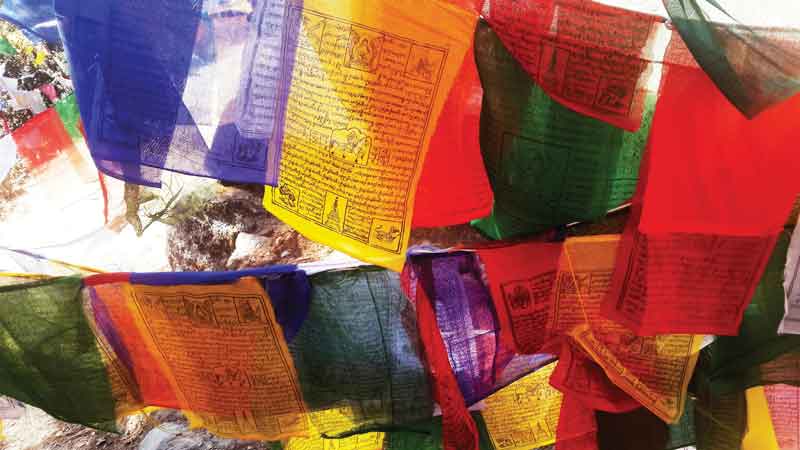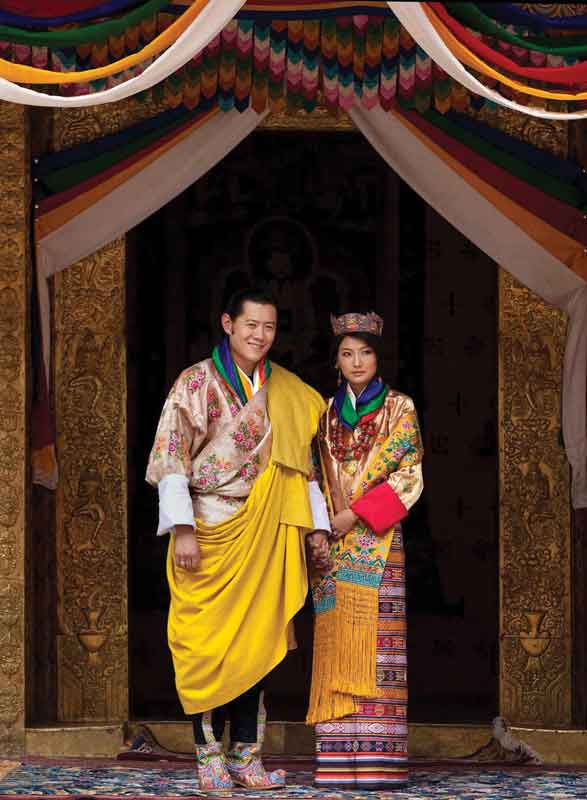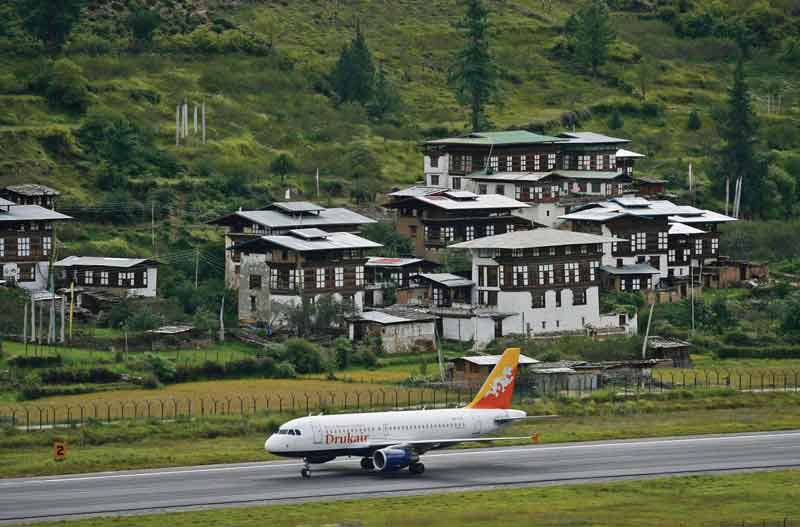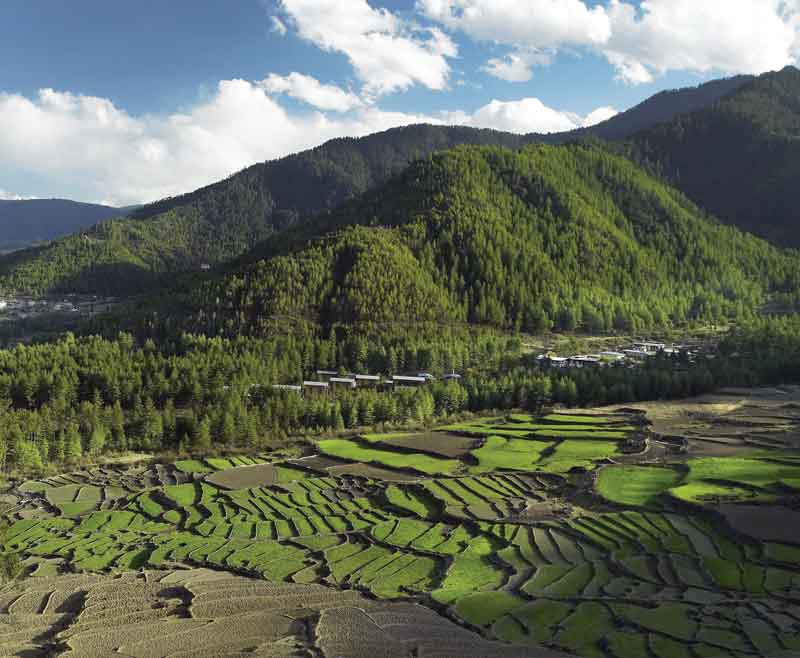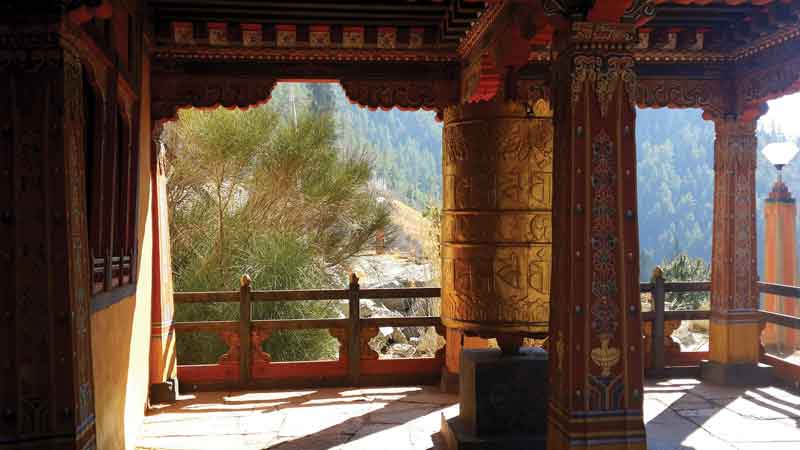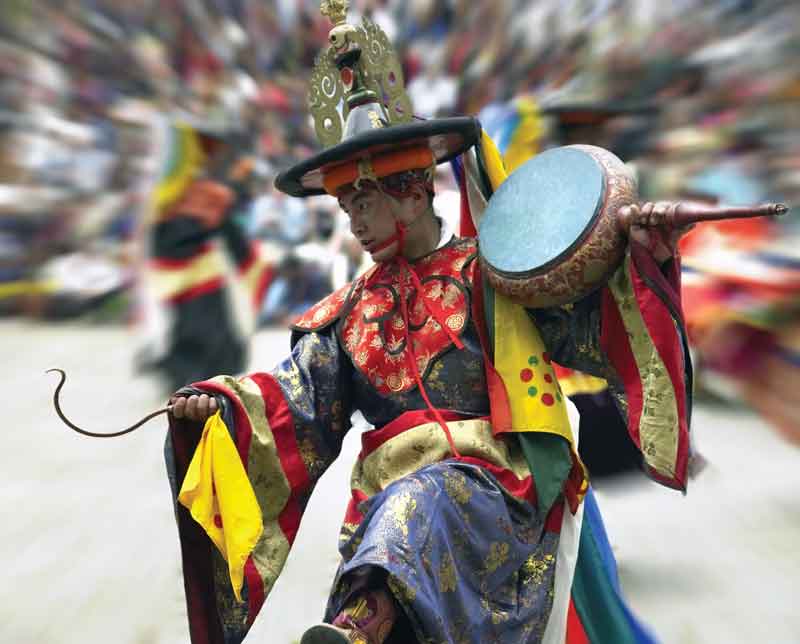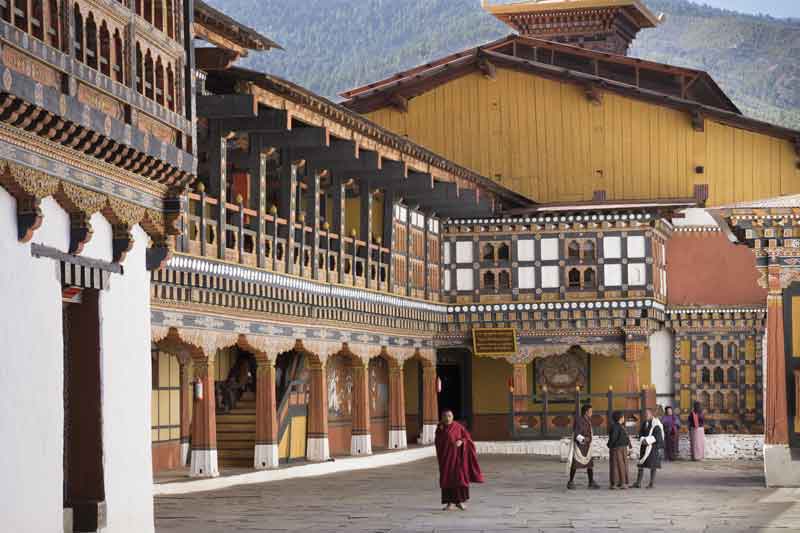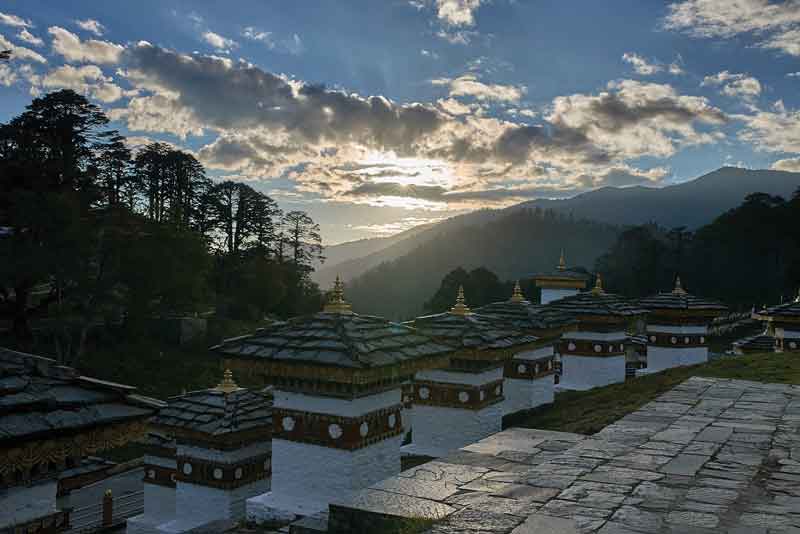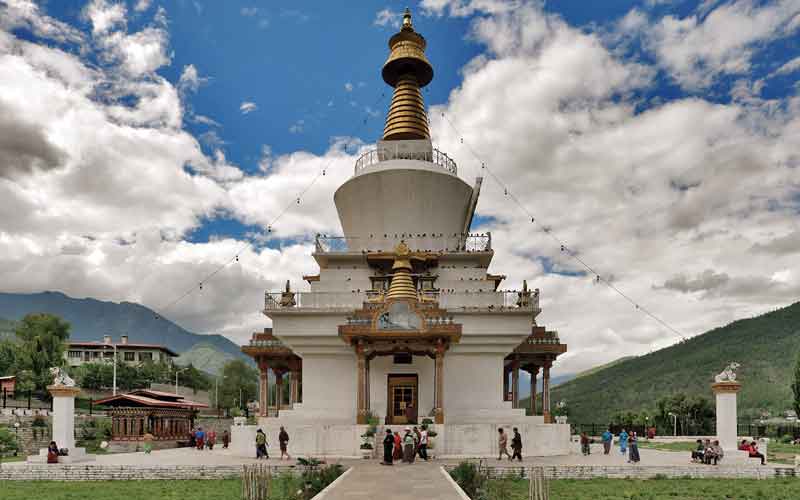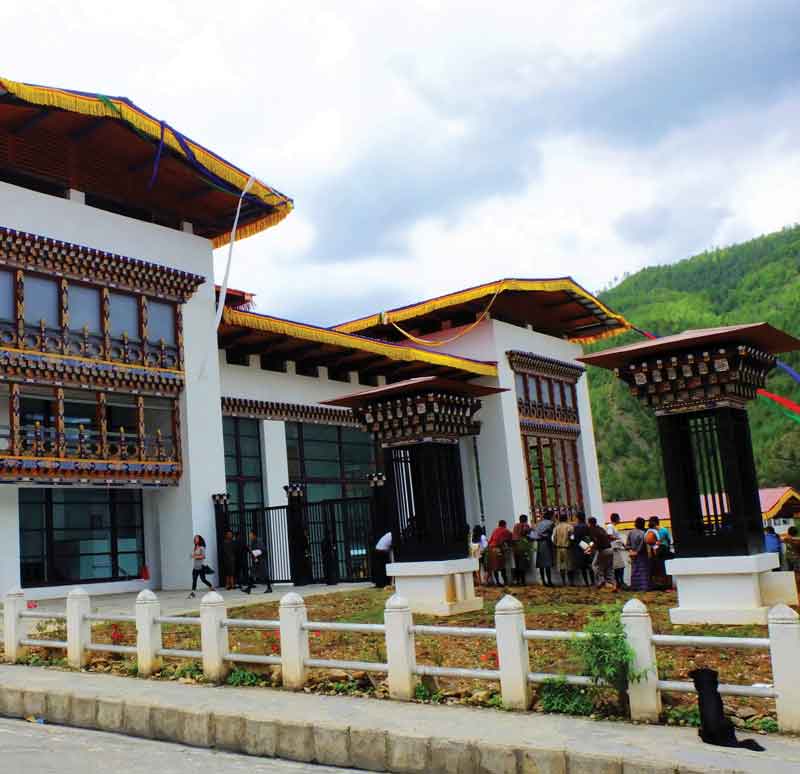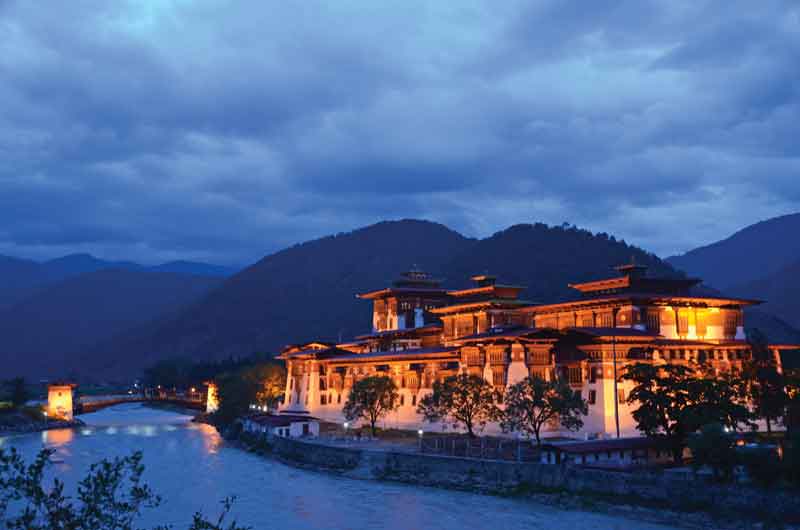Gross National Happiness
On planet earth, there are around 200 nations, out of which, only one promised to maintain neutrality in CO2 emissions forever. Eventually, they went beyond their offering and achieved negative numbers in terms of CO2 emissions, which reach four million tons of carbon monoxide per year. This land is called Bhutan, one of the few locations with an effective system for the conservation of its extraordinary biodiversity.
The Kingdom of Bhutan has no coasts. Its area spans 38,394 km2 and it’s a green oasis nestled between the great Himalayan mountain range. It borders the People's Republic of China to the north, which includes 470 km of the territory of Tibet, in the autonomous region of Xizang. To the west, south and east we find India; other neighboring countries are Nepal and Bangladesh. 72.5% of the kingdom is covered by woods, another 10% by snow or glaciers, and approximately 14% is populated or used for crops. The whole country is mostly mountainous, except for 16km of subtropical plains to the south end.
The origin of the name of Bhutan is likely to come from the Sanskrit Bhotanta, which means “the edge of Tibet” or perhaps from the Sanskrit Bhu-attan, meaning “highlands.” The inhabitants of the kingdom call themselves Druk Yul—the Land of the Thunder Dragon; a metaphor that alludes to the powerful storms that brew in the peaks of the Himalayas.
“…if the Government cannot create happiness (dekid) for its people, there is no purpose for the Government to exist.”
– Legal Code of Bhutan 1729
The Path to Buddhism
Bhutan is a self-proclaimed Buddhist country. They are, in its vast majority, followers of the Mahayana tradition (Great Vehicle)—an essentially magical branch, also known as Tantrism.
The Mahayana Buddhism is comprised of several symbols and rituals which purpose is to awaken and to develop the conscience with the purest energy of the being. The believer has to be guided strictly by a master, since it is only recommended to those with full control of the capabilities of their minds, those who have achieved total understanding of compassion, and those who are capable of containing the powerful freed energy through the tantric practice.
Buddhists believe the soul is destined to go through 108 stages in its journey. This number has several meanings in different universal philosophies; it is a sacred number. For example, you can find 108 beads in the rosary, or “mala,” that monks use in meditation prayers, because they have to complete 108 prayers to reach a deep meditative state thanks to the 108 lines of energy that connect to the heart chakra. The list of analogies would be endless: information just as mysterious as the very own essence of this amazing kingdom.
Buddhism and mysticism are present in the national flag as well: yellow represents the temporary power of the king, while orange embodies the power of Buddhism, and the figure of the thundering dragon stands out in the center. There are other religions in Bhutan, mostly because in the southern regions there are many followers of Hinduism (a combination of ideas and religious, philosophical and cultural practices that originated in India). There also prevail followers of Bön (an ancient Tibetan tradition that precedes Buddhism), animism (the belief that everything possesses a soul or spirit), and shamanism (related to supernatural powers, either developed or inherent to certain people).
There are two notable people in the development of Buddhist philosophy in the country: Padmasambhava or Guru Rinpoche (8th century), who is considered a second Buddha, and Tsangpa Gyare Yeshe Dorje (1594-1651), who unified the regions that were at war in Bhutan, becoming the political and spiritual leader of the kingdom. Buddhism has shaped the history of Bhutan and the people’s way of living.
The view of the cities—roads and villages in Bhutan—is decorated with the presence of prayer wheels and flags. This is so because these objects, when they move with the wind (from the smallest ones that the faithful and the monks wave in their hands, to the largest prayer wheels in the homes and temples) they spread hundreds of prayers, which are meant, indiscriminately, for every sentient being in the universe.
The Country that was Never Colonized
Long periods of its history are unknown. This is due to natural disasters and recurrent fires. If anything, it is thought to have been inhabited since archaic times—probably around 200-1500 BC. And it is important to point out that even though it was exposed to periodic invasions (Tibetan, Chinese and Indo-British), Bhutan has retained its autonomy since its foundation.
However, British forces from India caused numerous conflicts that concluded in 1865 with the signing of the Treaty of Sinchula; thanks to that, Bhutan was to receive an annual subsidy in exchange of a portion of its bordering regions. Another document that was signed in 1910 allowed Great Britain to oversee Bhutan’s external affairs, but never interfering in the internal affairs. In 1949, a formal Indo-Bhutanese pact resulted in the return of some of the territory the British had previously taken. Nowadays, India is the main partner and ally of Bhutan.
The Time of Philosopher Kings
On December 17, 1907 a unique monarchy was established with the coronation of Ugyen Wangchuck as the first king of Bhutan. He was a man skilled in the art of warfare, and at the same time he was merciful and religious, and with a preeminent vision for the future, he cemented the foundation for a virtuous reign. He was a great protector of monastic bodies across the nation and a fervent promoter of the training of youths in Buddhism; his reign came to an end with his demise in 1926.
His son, Jigme Wangchuck, was crowned immediately, and his reign lasted until his death in the year of 1952. By then, he had accomplished to build an established nation that, even though it was strictly isolated from the world, he had planted the seed for the arrival of the great innovator of Bhutan: the third king Jigme Dorji Wangchuck.
This young king set off the path to opening Bhutan’s doors to the outside world. He introduced the judicial system and agriculture. He created the first National Assembly, Royal Advisory Council and formulated the first unicameral parliament in the country; additionally, he established the five-year economic plans from the1961-1966 period, which remain in force. During his reign, Bhutan was recognized by the UN as a sovereign state in 1971.
After his sudden death, he was succeeded by the fourth king Jigme Singye Wangchuck with barely sixteen years of age. One of his accomplishments was the transition to a constitutional monarchy. He also transferred most of his power to the Council of Ministers, introducing a more democratic form of government; but his biggest contribution, not only to Bhutan, but to the rest of the world, was the creation of a new way to measure progress: instead of the Gross Domestic Product (GDP), he implemented the Gross National Happiness (GNH), which is a source of pride for the inhabitants of Bhutan. It is based on the following indicators: good governance, balanced economic development, conservation of the environment, as well as the preservation and promotion of culture.
In 2006, with only 56 years of age, he abdicated in favor of his son Jigme Khesar Namgyel Wangchuck, who graduated from Oxford University, where he got a degree in politics and international relations. During his coronation speech, he said: “Throughout my reign I will never rule you as a King. I will protect you as a parent, care for you as a brother and serve you as a son.” He is the only absolute king in history to have voluntarily asked his people to accept and allow the instauration of an electoral democracy, which results in limiting his power. This is the road taken by the philosopher kings of Bhutan.
http://www.grossnationalhappiness.com
The Road to Bhutan
The distance between Mexico and Bhutan is 14,158 km; to get there, you need to make a stop in Europe with Bangkok (Thailand), Kathmandu (Nepal), Delhi or Mumbai and Singapore as a destination. From each one of these locations it is possible to take a flight in Bhutanese airlines Druk Air or Bhutan Airlines, since only their pilots are qualified to land in the only international airport of the country, nestled in the city of Paro. This is due to the complexity of the runway, surrounded by the mountain range—which, in Bhutanese territory, shelters the only undamaged woods in the Himalaya with its high peaks.
Curiously enough, Bhutan is home to the highest unclimbed mountain in the world: the Gangkhar Puensum at 24,836 ft. high. It is said that these formations are considered sacred by the Bhutanese; this is so, that they banned climbing any mountain over 19,685 ft.
There weren’t any roads, cars, telephones, postal service or electricity across the territory until the 60s. The first tourists began arriving in 1974, since airport services began only in 1983. They didn’t have access to television; the signal was introduced for the first time in 1999, first with only one channel. A year later—with the start of the 21st century—it was expanded to 49 international channels.
During the year of 2000, the internet was also introduced. An unknown world arrived with these contemporary technologies to the eyes of the inhabitants of Bhutan, focused until then on preserving their deep Buddhist traditions, on the importance of family and their sight full of the rudimentary panoramas of their surroundings.
City of Paro: History and Nature
Upon leaving the airport, a journey begins; it will guide the visitor to discover its natural beauty: unique structures, temples and monasteries, all under the flow of spirituality that is present in the environment. This leads us to remember a teaching from Buddha: "Just as a candle cannot burn without fire, men cannot live without a spiritual life".
The city of Paro is a fertile valley located 2,300 m above sea level. Its streets are a mixture of the ancient and the modern, since most of the buildings have adapted their lower floors to open business, restaurants and other recreational sites. At the same time, the city harbors some of the most ancient and worshiped temples and monasteries in Bhutan: lively spaces, centers for the religious, cultural, educational and political activities of the country.
DZONG (fortress monasteries) are ancient Bhutanese architectural master pieces, built in places of great religious significance, and are present all across the territory.
The Fortress of the Heap of Jewels
Dzong de Rinpung
At the shores of the fast-flowing river of Paro stands this fortress monastery, which can be reached by crossing a beautiful bridge built above the waters. The monastery dates from 1644 and history asserts it was built by the founder of Bhutan: Zhabdrung Ngawang Namgyal. This Dzong is currently the administrative office of the Paro District and the school of the Monastic body for the religion of the eastern region of the country. It also hosts one of the most significant festivities, called Paro Tsechu, which offers one of the best ways to experience the ancient culture that still lives in Bhutan.
The Tiger’s Nest
Taktshang Goemba Dzong
In Paro you can also find the famous monastery called the Tiger’s Nest. Its construction represents an architectonical feat, because the structure practically hangs over a cliff at the side of a mountain, 3,100 m from the ground. The construction of the monastery began in 1692, in honor of the guru Padmasambhava; it is divided in four main temples and it is a cultural symbol for Bhutan. It was rebuilt recently due to a catastrophic fire in 1998.
Other places of interest in Paro are: the Buddhist temple Kyichu Lhakhang, built in the 7th century, one of the oldest monasteries in the country. We find the Dungtse Lhakhang as well, a small temple that keeps paintings that narrate the evolution of Tantric Buddhist philosophy, their deities and main heroes.
National Museum of Bhutan
The museum was inaugurated in 1968 to shelter a great tradition comprised of 3,000 works of art, which span around 1,500 years of history. Their mission is the “Preservation, Promotion and conservation of tangible and intangible cultural heritage towards the fulfillment of Gross National Happiness".It is located in a monument from the 17th century. Its expositions display textiles, jewelry, craftwork, silk signatures and stamps. The upper floor features a “tree” that represents the main figures of the four main schools of Buddhism.
Abril-octubre de 9 a.m. a 5 p.m.
Noviembre-Marzo de 9 a.m. a 4 p.m.
P.O. Box No. 1227, Paro, Bután
+ 975 8 271511
This email address is being protected from spambots. You need JavaScript enabled to view it.
http://www.nationalmuseum.gov.bt
Thimphu, the Capital
It is the commercial, religious and governmental hub of Bhutan, with approximately 100,000 inhabitants, as well as the royal family. Here, you can find a variety of restaurants, cybercafés, malls, bars, ATMs, and a golf course; this is the place where the influence of “modern” life is tangible, although it still preserves its strong cultural identity. Nowadays, the effects of automobile traffic are present; however, there still are no traffic lights; in places where it is absolutely necessary, a policeman directs transit through manual indications.
The Fortress of the Glorious Religion
Tashichho Dzong
This is a Buddhist monastery and fortress located to the north of Thimphu. It had to be renovated and expanded several times throughout its long 800 years of existence. Currently, it is the headquarters of the government as well as a throne room, offices of the king, and other government dependencies. The entry gates are guarded by the divine figures of the chennizang, or protective deities. Next to this site, the Dechencholing Palace stands; this is where the royal family of Bhutan lives.
A Monument Dedicated to Peace
The National Memorial Chorten of Thimphu
The word Chorten means “seat of faith”; The Thimphu Chorten is a great stupa—a funerary monument dedicated to the peace, prosperity and harmony of the world—built as homage to the third king of Bhutan: Jigme Dorji Wangchuk. Monlam Chenmo (the Great Prayer Festival) is celebrated here each year. You can find these sacred structures across the Bhutanese territory, which were worshiped by pilgrims in ancient times. Nowadays, people make their offerings and meditate, walking in circles around it while in prayer.
Bhutan Textile Museum
The Textile Museum was founded in 2001, conceived and sponsored by Her Majesty the Queen Ashi Sangay Choden Wangchuck. Its exhibition rooms focus on six main themes: warp pattern weaves, weft pattern weaves, role of textiles in religion, achievements in textile arts, textiles from indigenous fibers and the royal collection.
Other places that shouldn’t be missed in Thimphu are: the National Library and Archives of Bhutan, keeper of a fundamental treasure of its history; its themes span religion, medicine, art and culture. Another interesting place is the Folk Heritage Museum, offering an insight into the Bhutanese traditional lifestyle. It is also a must to visit the Buddha Dordenma statue; it was built in 2015—a colossal figure 51m high. It harbors a spacious temple for meditation inside. It has become a prominent pilgrimage site with high touristic appeal. The monument stands on a hill, where it is possible to overlook the panorama that surrounds the capital.
For those interested in traditional products of Bhutan, during the weekends, at the Centenary Farmers Market, you can find a vast offer from every corner of the country; in the streets of the city, you can acquire craftworks, specialized books on Buddhism and other subjects of interest; works of art, wood carvings, essential oils, and weavings, etc.
In terms of art galleries, the offer includes the Water Dragon Gallery (www.facebook.com/Water-Dragon-Gallery-361158300615032/), dedicated to Bhutanese contemporary art, directed by the painter Pema Tshering, and the Alaya Art Gallery, established by the non-profit association VAST (http://www.vast-bhutan.org/), dedicated to promote the artistic heritage of the country.
There are other regions and cities in this territory where the magnificence of the biosphere is preponderant; urbanization has not yet reached them entirely, in communities that are rich in culture, dialects, with their own traditions and a rhythm that is signaled by happiness.
Museo Textil de Bután
Lunes a sábado de
9:00 am a 4:00 pm
P.O. Box: 1551 Chubachu
Timbu – 11001, Bután
+975 2 335 117
http://www.royaltextileacademy.org/
Tourism Council of Bhutan
Consejo de Turismo de Bután
Post Box 126 Timbú, Bután
+975-2-323251
This email address is being protected from spambots. You need JavaScript enabled to view it.
Asociación de Tour Operadores de Bhután
Drimey Lam, Timbú, Bután
+975 2 322 862
Text: Maruchy Behmaras ± Photo: RED TRAVEL / •© NILDA PARALITICI / VIAJET / PLANETA FELIZ / ESCAPEDIS / AES / PADONA / AE / © HUNGCHUNGCHIH / © BLOOPIERS / PD / © FEIJE / RIEMERSMA / © SAMRAT35 / © HUNGCHUNGCHIH / VOPA / PD / JEREMY / IMGUR / PENS STARER2 / RHEFRFS / BHUTAN / GF / SERENDIPITI XPRESS / © STEVE ALLEN / SUNLITNIGHTS / © PICHAYA PEANPATTANANGKUL / © JEEWEE / © AVIKGENXT / © SAMRAT35 / © WOUTER TOLENAARS / ALWAYS BHUTAN / UEW / JOHNSTANLAKE / MEDIA.GADVENTURES / MARC.PECQUET / NATIONAL GEOGRAPHIC / OAS / ANANDOART / EG HOAL / EVE MUSEOGRFAFIA / TERRIS SCHNEIDER / Gelay Jamtsho by Bhutan-360

